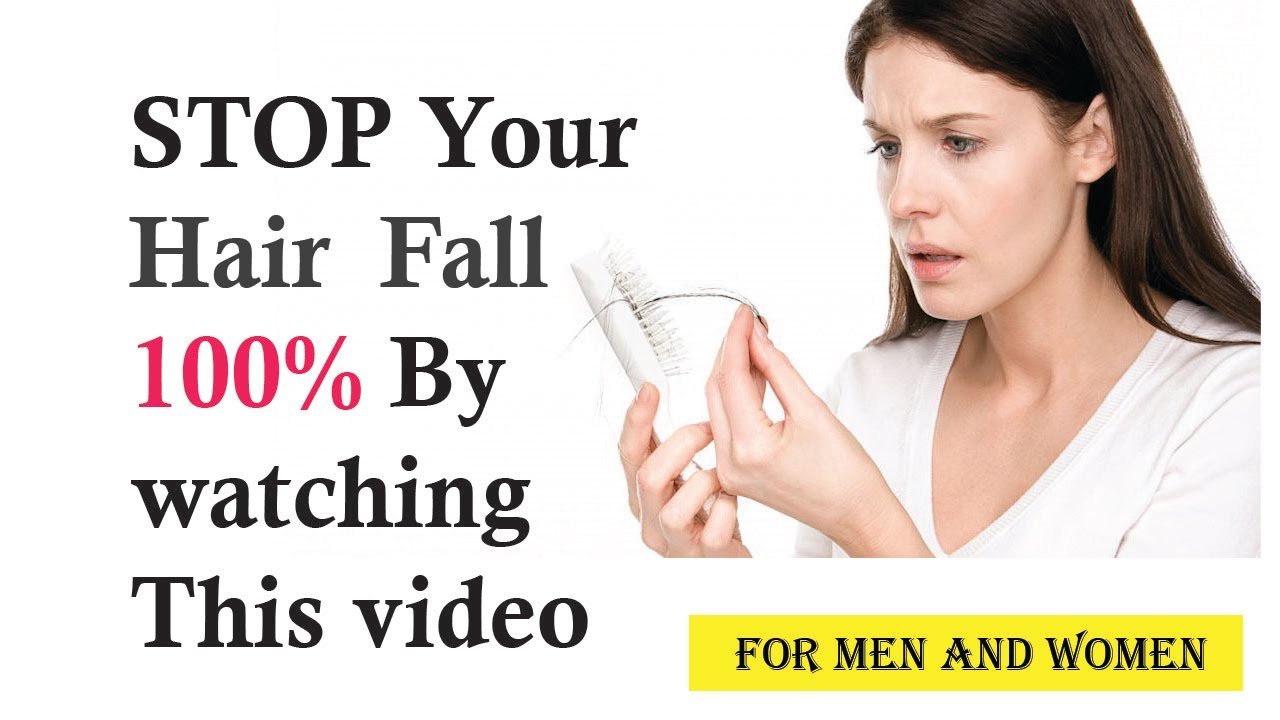Causes Of Female Balding
1. Genetics/ Family history of hair loss2. Autoimmune disease such as alopecia areata3. Illness such as severe infection, high fever or surgery4. Traction alopecia, which can occur due to frequently wearing hairstyles that pull the hair too tightly5. Hormonal changes due to pregnancy, childbirth, menopause and thyroid problems6. Medications and supplements such as those used for cancer, arthritis, depression, heart problems, gout and high blood pressure7. Radiation therapy to the head8. An extremely stressful event that causes physical or emotional shock9. Hot oil hair treatments10. Vitamin deficiency such as iron deficiency11. Restrictive diets
What Are The Myths About Hair Loss
Myths about hair loss are widespread. Nothing in the following list is true:
- Youre losing hair because you shampoo it too much, or because youve colored it or gotten a perm.
- Dandruff causes permanent hair loss in women.
- Stress causes permanent hair loss in women.
- If you shave your head, your hair will grow back twice as thick.
- If you stand on your head youll increase circulation, stimulating hair growth.
- If you brush your hair 100 strokes a day that will make your hair healthier.
- Hats and wigs cause hair loss in women.
- Hair loss only affects intellectual women.
There Are Different Types Of Hair Loss Genetic And Reactive
Genetic:
There’s a chance you’re genetically predisposed to hair thinning, which means you may see a progressive, gradual reduction in hair volume. “In these instances, certain hair follicles are sensitive to male hormones and this sensitivity causes follicles to gradually shrink and produce slightly finer and shorter hairs with each passing hair growth cycle.” Explains Anabel Kingsley.
Reactive:
This means your hair loss is the result of a trigger. “Excessive daily hair shedding is not reliant on having a genetic predisposition, it occurs as the result of an internal imbalance or upset, such as a nutritional deficiency, severe stress, crash dieting or an illness” says Anabel Kingsley.
Also Check: When Does Postpartum Hair Loss Happen
Types Of Hair Loss In Women
Here are some of the most common types of hair loss:
How To Stop Menopausal Hair Loss According To A Trichologist

Lets face it If youre a woman, youre eventually going to experience the dreaded menopause. Hot flashes, mood swings, insomnia, weight gain. And, if that isnt enough, millions of women experience hair loss during menopause. Most doctors declare menopause as an estrogen-deficient time, where a womans estrogen level drops by 90%, so there may be even more hair loss after youve completed menopause.
Also Check: Will My Thinning Hair Grow Back
Be Gentle With Your Hair
At this time when your hair is at its weakest, you need to be gentle to prevent excessive shedding. During hair wash, massage your scalp in gentle circular motion. Wash in a downward direction instead of piling your hair up in order to reduce tangles. Consider having a haircut. Trimming away the dry ends of your hair may reduce tangles and pulling while combing your hair. Avoid ingredients like sulfates, parabens, alcohols and artificial fragrance in your hair products. Also, stay away from heat styling and chemical hair treatments such as perming and re-bonding.
Are There Complications/side Effects Of Treatment
Minoxidil may irritate your scalp and cause dryness, scaling, itching and/or redness. See your dermatologist if this happens.
With Minoxidil you might also see hair growing in other places other than your scalp . Wash your face after you apply Minoxidil and make sure you avoid other areas when you apply it.
Recommended Reading: Can I Stop My Hair From Thinning
Symptoms And Risk Factors
Female pattern hair loss can present in a number of different ways, says Cohen, including thinning at the top or sides of the head or widening of the central part.
While your risk of hair loss grows with age, there are also other risk factors that increase your chances of hair loss including:
- Women who are older than 40
- Women who have already been through menopause, especially if they are also taking testosterone.
- Women with a vitamin D deficiency
Can Hair Loss Be Reversed
Yes and no. It depends on what type of hair loss youre experiencing.
Some types, like cicatricial alopecia, are permanent, while others that may be caused by stress or a medical condition are temporary. Once the cause has been identified and eliminated, your hair should start growing back.
Generally speaking, if the trigger goes away or whatever caused the injury to the hair follicle, then the hair will recover over a period of four to six months to a year, says Dr. Bergfeld.
Read Also: What To Do With Hair Loss After Pregnancy
Does Menopause Cause Hair Loss
The hair follicle, a complex mini-organ with its own blood supply, requires a great deal of metabolic energy to reproduce itself, and its one of the most sensitive among all of the organs. That means it is easily affected by even subtle shifts in energy, which can lead to hair loss.
The long-standing belief is that the hormonal imbalances that occur during menopause when the body produces less estrogen and progesterone trigger the production of androgens , leading to hair loss. This is caused by an increased sensitivity to testosterone, the androgen, which turns into or DHT . Over time, the DHT causes the hair to miniaturize, until the hair is barely visible. This is known as post-menopausal hair loss.
Instagram /
Before a woman has her last period, she may be estrogen dominant, meaning she has too much estrogen relative to her bodys progesterone production. This happens when the estrogen begins to overstimulate the body and the brain. Estrogen dominance may occur for 10-15 years, beginning as early as the age of 35, until menopause officially begins. All of these symptoms are exacerbated by stress of many kinds.
Female Hair Loss : Why It Happens And How To Treat It
Medically reviewed by Kristin Hall, FNP
Noticed your hair falling out? Whether youve spotted more hairs than normal on your pillow, in the shower drain catch or on your clothing, its easy to panic when you notice your hair thinning at a faster pace than normal.
Female pattern hair loss is the most common type of hair loss women experience.
Hair loss in women can occur for a variety of hair types and reasons. Sometimes, its triggered by changes in your hormone levels and a genetic sensitivity to certain hormones. In other cases, factors such as stress, thyroid issues , weight loss and even environmental factors can all have an effect on your hairline.
As a woman, dealing with hair loss can be difficult. Luckily, its almost always treatable using a range of safe, effective medications. Weve covered these treatment options, as well as the key reasons for female hair loss, below.
You May Like: What To Help Hair Loss
How Can I Tell If I Have Female Pattern Hair Loss
Its best to make an appointment to see a dermatologist. Dermatologists are the experts in diagnosing and treating hair loss. A dermatologist can tell you whether its FPHR or something else that is causing your hair loss. Other causes of hair loss can look like FPHL, so its important to rule out these causes.
Different Types Of Hair Loss

There are lots of different types of hair loss. It can take the form of “thinning” or involve a total loss of hair. It can be gradual or sudden it can affect the old and the young.
Hair loss can be genetic, or as a result of extreme stress, a medical condition or treatment.
Hair loss is a well-known side effect of chemotherapy. It’s also common for women to lose more hair than usual up to 3 months after they’ve given birth.
Don’t Miss: How To Repair Hair Loss
Emotional Or Physical Stress
This is one of the main and common causes of hair loss in women. This type of case can come as a result of trauma, divorce, surgery, and so on these can all be key stress-inducing factors, and, therefore, you may notice a significant amount of hair fall during any of these periods.
It often comes as a result of your body putting lots of efforts into directing its resources towards resolving the situation. Additionally, physical changes such as high fever, sudden weight loss, and so on, can equally lead to hair loss.
How Common Is Hair Loss In Women
Many people think that hair loss only affects men. However, it is estimated that more than 50% of women will experience noticeable hair loss. The most significant cause of hair loss in women is female-pattern hair loss , which affects about one-third of susceptible women, which equals out to some 30 million women in the United States.
Read Also: How Much Does A Hair Loss Consultation Cost
Whats Hair Loss In Women
Hair loss in women is just that when a woman experiences unexpected, heavy loss of hair. Generally, humans shed between 50 and 100 single hairs per day. Hair shedding is part of a natural balance some hairs fall out while others grow in. When the balance is interrupted when hair falls out and less hair grows in hair loss happens. Hair loss is different than hair shedding. The medical term for hair loss is alopecia.
Hair grows on almost all of your skin surfaces not the palms of your hands, soles of your feet, lips or eyelids. Light, fine, short hair is called vellus hair. Terminal/androgenic hair is thicker, darker and longer.
When To Seek Help
You should consult your doctor if:
- You are losing hair in an unusual pattern
- You are losing hair rapidly or at an early age
- You have any pain or itching with the hair loss
- The skin on your scalp under the involved area is red, scaly, or otherwise abnormal
- You have acne, facial hair, or an abnormal menstrual cycle
- You have additional symptoms which concern you.
Read Also: Is Aloe Vera Good For Your Hair Loss
What Steps Can I Take To Prevent Or Slow Hair Loss
Unfortunately, certain types of hair loss are genetic, and very little can be done to prevent them. Genetic types of hair loss include alopecia areata and female pattern hair loss.
But other types of hair loss can be brought on by stress and a poor diet. Do your best to eat a balanced diet, and find ways to take care of your mental health.
For added benefit, stay up to date with your routine checkups. Anemia, low levels of vitamin D and abnormal thyroid hormones can all affect the health of your hair. Simple bloodwork from your primary care physician can determine if these conditions are contributing to your hair loss.
Black women in particular are prone to a type of hair loss called traction alopecia, which is caused by heat, chemicals and tight styles that pull at the hair root, including some braids, dreadlocks, extensions and weaves.
Shampoos For Hair Loss
Shampoos that moisturize the scalp can create a healthy environment for hair regrowth. Anti-dandruff shampoos like Head & Shoulders and Dove Dermacare Scalp contain zinc pyrithione , an ingredient that removes dead skin cells that could be preventing growth. Plus, all of that itching and scratching from a dry scalp can lead to excess shedding.
Whats more, hair thinning can also stem from a hormone called DHT . DHT signals hairs to shrink and become vellus hairs , says Caroling Chang, MD, a board-certified dermatologist at Rhode Island Hospital and member of the Prevention Medical Review Board. It does this by changing the hair cycles and causing a shortening of the growth phase and increase in the resting phase, she explains. In this case, consider a DHT-blocking shampoo like Alterna Haircare.
Don’t Miss: What To Do For Hair Loss Male
Why Hair Falls Out
Hair grows and eventually falls out as part of its normal cycle. It can build up on hair brushes, pillows, or shower drains.
Most people will not notice the natural hair loss that occurs daily. Hair thickness and the hairline usually remain the same.
People are more likely to notice excessive hair loss. This is a good time to take action as it may be due to an underlying condition. Symptoms of excessive hair loss include:
- sudden loss of hair
- noticeable thinning
There are several possible reasons for excessive hair loss.
One of the most common causes is due to genetics. According to a 2019 review, pattern baldness affects up to 50% of men and women.
Commercial products could help to slow and treat this type of balding. One example of these products is Rogaine.
Pattern baldness occurs slowly with aging. Some more immediate causes of hair loss include:
Complications Of Hair Transplantation Surgery

Complications of hair transplant surgery can include:
- Infection this can occur because the skin is broken to perform the procedure. It can be treated with antibiotics.
- Bleeding this is usually controlled through careful post-operative care.
- Scarring this may occur at the site of removal of the donor follicles.
- Temporary, operation-induced hair loss known as telogen effluvium, can occur with hair transplantation, as well as some other operations. It occurs in approximately five per cent of people.
- Unacceptable cosmetic results scarring and poor cosmetic results are more common when hair transplants are carried out by inexperienced practitioners.
Many hair clinics offer hair transplantation. Specialist dermatologists are best qualified to properly advise about this surgery and have the most knowledge about hair in health and disease.
Recommended Reading: What Causes Sudden Hair Loss